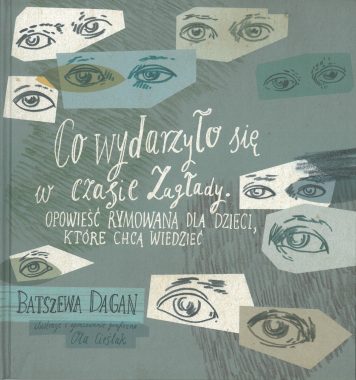Author: Bat-Sheva Dagan [בת שבע דגן]
Illustrator: Ola Cieślak
Translator: Szoszana Raczyńska
Year: 2012
Publisher: Opera i Filharmonia Podlaska – Europejskie Centrum Sztuki w Białymstoku
Place of publication: Białystok
Pages: 32
ISBN: 9788363806033
Notes: Translation from Hebrew (1991).
Translations:
- מה קרה בשואה: ספור בחרוזים לילדים הרוצים לדעת, ill. א. כץ, Tel-Aviv: Maor, 1991, pp. 22;
- What happened in the Shoah? A story in rhyme for children who wish to know, ill. S. Heller, Cleveland, Oh: Kay Teen, 1992, pp. 32, ISBN: 9780954300180;
- Что пережил наш народ: рассказ о катастрофе, ill. А. Кац, trans. А. Ротман, Иерусалим: Джойнт, 2000, pp. 32.

In this first-person narrative, the author (as seen in one illustration) tells her young readers about “real events” related to the Holocaust. She finds its genesis in Adolf Hitler’s rise to power as he “decided to go … to war” with the Jewish people. As part of his anti-Semitic policies, Hitler took all of their belongings, including dogs. (Dagan devoted another book to this: her Czika, piesek w getcie [Chika, the Dog in the Ghetto]) Subsequently, he detained them in ghettos, from which he sent them to camps “in many places,” where they were exploited for slave labour, and died from illnesses and bullets. Two illustration spreads are devoted to the Jews’ armed resistance, with the brave Perec becoming its symbol. The story concludes at the end of the war, the liberation of prisoners from camps, Hitler’s suicide and the emergence of the state of Israel.
Due to its short, rhymed form, this first book by Bat-Sheva Dagan is characterized by an imbalance in giving significance to its tropes. For example, the genesis of Shoah, ghettos, and Jewish uprisings against Germans are all crowded in a single two-page illustration spread. At the end of the book, a short glossary can be found, including such terms as “ghetto,” “Israel,” “partisan,” or “Nazi Germany.” In the Polish edition of Co wydarzyło się w czasie Zagłady [What happened in the Shoah?], Ola Cieślik’s illustrations are particularly important as they engage in a dialogue with the text, making the message of the resulting picturebook more complex.
Bibliography:
- Jasnowski, P., Zagłada Żydów w najnowszej literaturze dziecięcej, „Ryms. Kwartalnik o książkach dla dzieci i młodzieży”, no. 19, 2013, pp. 6–7;
- Rybak, K., Obrazowanie Zagłady. Narracje holokaustowe w polskiej literaturze XXI wieku dla dzieci i młodzieży, Warszawa 2023 (s. 205, 224);
- Sikora, A., W jaki sposób mówimy dzieciom o wojnie? Charakterystyka prozy o tematyce wojennej na podstawie wybranych książek dla dzieci, „Acta Universitatis Lodziensis. Folia Librorum”, no. 2 (19), 2014, pp. 25–44 (pp. 29–30);
- Wójcik-Dudek, M., W(y)czytać Zagładę. Praktyki postpamięci w polskiej literaturze XXI wieku dla dzieci i młodzieży, Katowice 2016 (pp. 32–33).